Western Digital Expands HGST Helium Drive Lineup with 10TB Ultrastar He10
by Ganesh T S on December 2, 2015 3:01 AM EST- Posted in
- Enterprise
- Storage
- HDDs
- Western Digital
- HGST
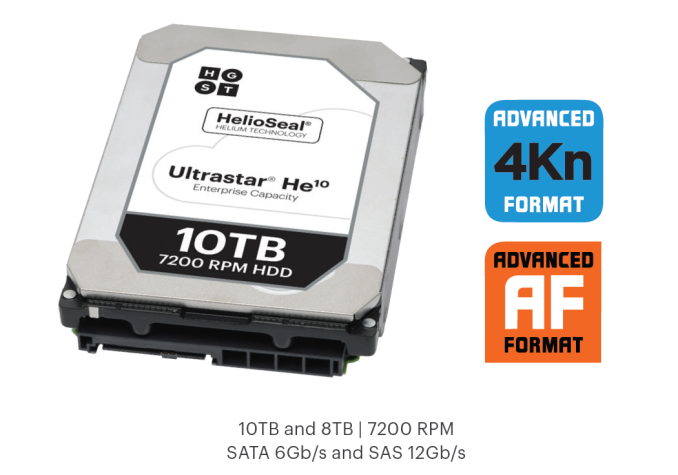
HGST, a Western Digital subsidiary, has been shipping hard drives sealed with helium for a couple of years now. Their helium drives have so far come in two flavors - the Ultrastar He drives using platters with traditional perpendicular magnetic recording (PMR) technology and the Ultrastar Archive Ha drives using platters with shingled magnetic recording (SMR). There are two main patented innovations behind the helium drives, HelioSeal and 7Stac. The former refers to placement of the platters in a hermetically sealed enclosure filled with helium instead of air. The latter refers to packaging of seven platters in the same 1" high form factor of traditional 3.5" drives.
The Ultrastar He6 6TB drive was introduced in November 2013, and this was followed by the He8 8TB drive late last year. In June 2015, the Ultrastar Ha10 SMR drive with HelioSeal technology was introduced. Around the same time, HGST also made it known that more than 1M HelioSeal units had been deployed. 1.33 TB platters have become available in air drives now, and HGST is taking advantage of that in the 10TB Ultrastar He10. The launch of the Ultrastar He10 PMR drive today also brings the news that more than 4M HelioSeal units have been deployed in various datacenters - pointing to the rapid rise in adoption rate of this technology.
We have already seen in our reviews that the helium drives offer the best performance to power ratio and watts per TB metric amongst all the drives in their capacity class. HGST also claim a 2.5M hour MTBF - much higher than traditional enterprise PMR drives. The initial cost of the helium drives have been substantially higher compared to the standard drives of the same capacity, but the TCO (total cost of ownership) metric is highly in favor of these drives - particularly for datacenter customers who need the drives to be active 24x7. HGST's press briefing included a slide that presented the potential TCO benefits that come about due to the increased capacity per rack, lower consumption per rack and lower power consumption per TB of the new He10 drives.
HGST indicated that the ramp in volume should help the initial cost to approach that of the air drives in the near future. For datacenter customers, that would mean an acceleration in obtaining the TCO benefits.
Coming to the core specifications, the Ultrastar He10 will come in both SATA 6Gbps and SAS 12Gbps varieties. The drives have 4KB sectors, though SKUs with 512-byte emulation are also available. Various data security options such as instant secure erase, self-encryption, secure erase and TCG encryption with FIPS are available.
The standard Ultrastar He drive features such as rotational vibration safeguard (for better RV tolerance in multi-drive servers) and the rebuild assist mode (for faster RAID rebuild) are retained. The drives come with a 256MB DRAM buffer.
Hard drives are struggling to reach the 10TB capacity point with traditional PMR technology. While Seagate did announce a few 8TB PMR drives earlier this quarter, it really looks like vendors need to move to some other technology (shingled magnetic recording or heat-assisted magnetic recording (HAMR)) in order to keep the $/TB metric competitive against the upcoming high-capacity SSDs. As of now, helium seems to be the only proven solution causing minimal performance impact and HGST appears to have a strong hold in this particular market segment.


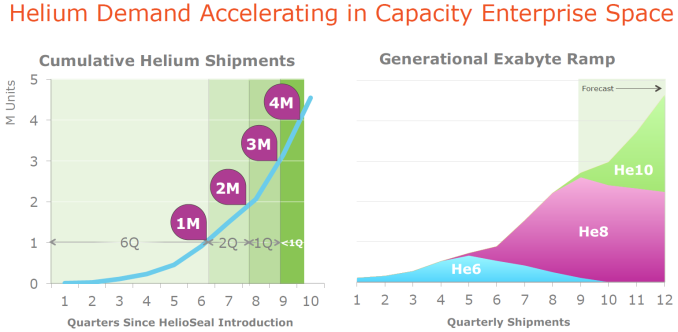
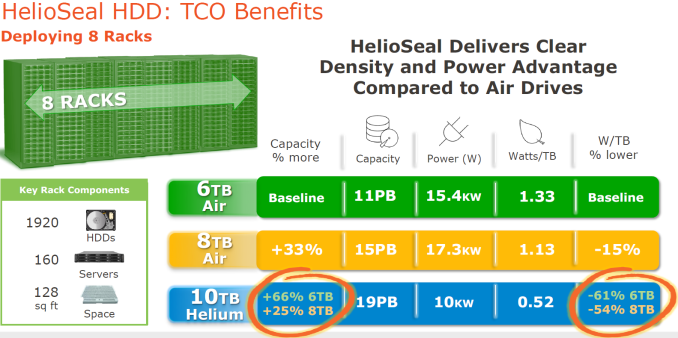
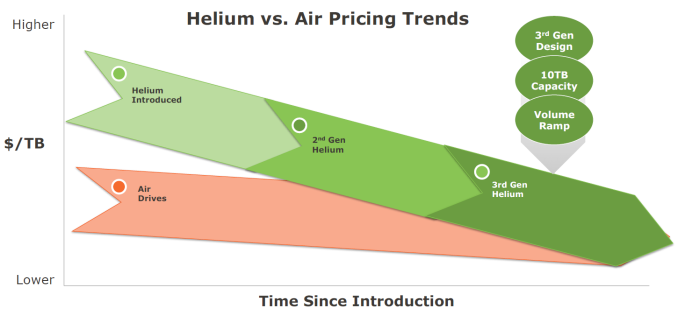
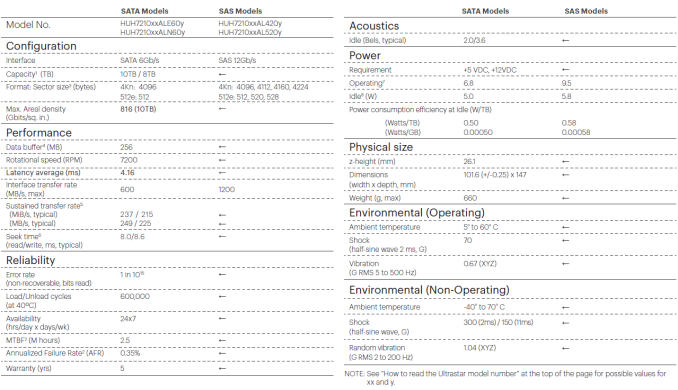
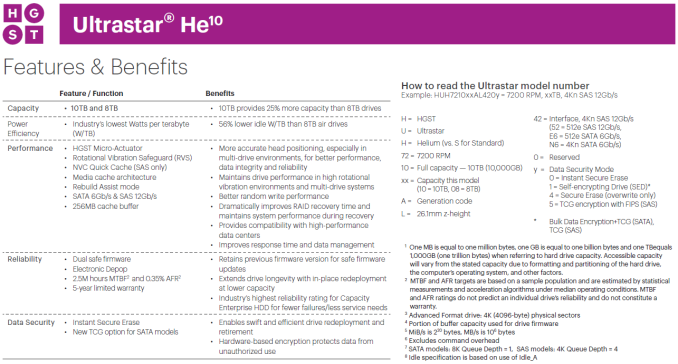








113 Comments
View All Comments
close - Thursday, December 3, 2015 - link
Quick question: why would you go for standard sizes like 5.25"? That's the platter size, not the disk size, so you can still go with 3.5" platters in a larger enclosure in order to cram in more independent heads or just to stack more platters in. Or why 5.25? Maybe the best compromise is a 4.2" platter. Any research on this or are you just assuming and speculating without facts?Also, because you assume people sticking with 3.5" is anything more than compatibility and reduced manufacturing costs that go beyond just the simple HDD unit I will say that most cars run on gasoline now so electric sucks, most LAN connections top out at 100Mbps so gigabit is no good, etc.
You should really research causality and correlation.
ddriver - Wednesday, December 2, 2015 - link
Funny, you consider 5-6 GB/sec and quadruple capacity "minor benefit". At the risk of repeating myself, those things were attempted way before their time, using immature technology. That's why they failed. Actually, independent head and actuators, when mass produced, will have a negligible impact or both cost and weight. All it takes is vastly improved firmware capable of operating them independently.Take wireless power - that dude Tesla did it more than a 100 years ago, and someone like you might say "it got extinct" but in reality, it was simply a century ahead of its time. As you see, now wireless power is a big and growing thing.
You seem to harbor a misconception that the industry is interested in innovation and improvement - on the contrary, the industry is only interest in making money, and having an easy time doing that. Thus they keep milking existing tech for as long as possible, keep things simple, because too good of a new product would kill their existing business. And they stay away from innovations until it is unavoidable and badly necessary, not to the users, but to the industry. It is really not that such hard drives are too complex or technically impossible, it is just that they'd be way better than what the industry would like to offer the consumer. They can't afford that, because next thing you know, the consumer is transformed from a paying tool to a progressing person with high standards of expectations.
FunBunny2 - Wednesday, December 2, 2015 - link
-- it is just that they'd be way better than what the industry would like to offer the consumer.IBM dumped the 33XX DASD for emulating CKD/VSAM files on 3.5 commodity drives. Why? cheap.
BurntMyBacon - Wednesday, December 2, 2015 - link
@ddriver: "... they stay away from innovations until it is unavoidable and badly necessary, not to the users, but to the industry."Agreed. However, I would argue that it is unavoidable and badly needed immediately if not sooner. The industry has been loosing an increasingly large portion of sales to SSDs. If they have any innovations that could make the move to SSDs less appealing, they would do well to use them.
ddriver - Wednesday, December 2, 2015 - link
Back in the days where those disks "failed", there weren't any chips capable of running such a device at high rpm. Since then technology has improved tremendously, both in terms of mechanics, manufacturing, but most notably - chip performance.Calling this a failure is like calling space exploration a failure, just because 200 years ago someone tried to do it with an oversized kite and failed miserly.
Of course you are going to fail if you get ahead of yourself and try to accomplish something you don't have the technology for. But that doesn't mean an "ultimate failure" - it just means "everything in its time". Today technology is finally up to the task, but the industry still prefers having its sweet time milking the old tech, made so much easier by the advances in technology. Why should they bother to make such a giant leap, when as long as the consumer has no other choice he is going to buy the existing product line.
edzieba - Wednesday, December 2, 2015 - link
The previous issues with large-diameter platters were not electronic, they were mechanical. A larger platter spinning faster is much more vulnerable to instability, and needs to be mechanically stronger (thus thicker and less volume efficient, and harder to spin up/down).The actual mechanism of HDDs is very mature. In the last decade, the only evolution has been in head technology (GMR) and orientation (PMR). Helium filling has allowed closer platter spacing, but will not allow larger platter sizing.
ddriver - Wednesday, December 2, 2015 - link
"The previous issues with large-diameter platters were not electronic, they were mechanical."Because the electronics at the time were so inferior they didn't even conceive independent multiple heads per platter face. Thus they didn't even run into the electronic problems, only faced the mechanical. As I said at least a few times already - lower PRM would not be an issue with independent heads. Two heads at 5k will give you equal or better performance than one head at 10k, and extra redundancy. And it will end up being more energy efficient as well.
NonSequitor - Wednesday, December 2, 2015 - link
http://www.tomshardware.com/news/seagate-hdd-hardd...It's been done before. One of the big barriers was the different rates of heat expansion for the different servos. At current densities it would be a lot of work for very little benefit, particularly since lower speeds means higher latencies, which absolutely kills performance.
ddriver - Wednesday, December 2, 2015 - link
LOL, servos - enough said. This thing is a relic. Voice coil actuators won't have such a problem. 4 heads per platter face seems like the sweet spot, although even six are still possible without getting in each other's way.Two heads at 5k RPM would be just as fast, and often faster than one head at 10k RPM. Two heads will offer the same throughput at lower RPM, saving on energy. Now if you have concurrent access, one head will have to move back and forth between the two locations, wasting more time on access than actually reading data. 2 hears can do that without the access, as they can simultaneously access the platter at different positions at the same time.
FunBunny2 - Wednesday, December 2, 2015 - link
-- Because the electronics at the time were so inferior they didn't even conceive independent multiple heads per platter face.mainframe and mini drives, even those with removable disk packs, had multiple independent head sets for decades. as to RPM, remember these devices had 14 inch diameter platters. given the laws of physics, I'd wager that angular velocity for most of such a platter is at least what we have today.